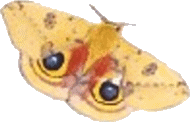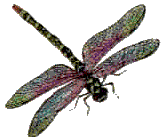Saturday, December 07, 2002
HYBERNACULA
Perhaps the strangest thing was that I didn’t really know for sure how long the bat had been in my house. In retrospect, throughout some of the recent clusterfuck and scramble that makes up the end-of-the-semester death spiral, I vaguely remember hearing a clicking sound late one afternoon shortly after returning home from the office. The landlord was downstairs in the basement at the time working on installing a washer and dryer and there was an additional service truck pulled up in the back alley. “Huh,” I remember thinking to myself, “they must be checking for radon. Huh.” The quirkiness of this particular logic did not, I think, occur to me at the time, and I remember feeling pretty solid about my conclusion, despite its oddity. Furthermore, I didn’t think too much of it, when, several days later, I heard the clicking once again, despite the fact that it was around 10:00 p.m. at night, and there were no servicemen in the basement to account for the presence of the metal-detector-like clicking sound. “Huh,” I thought to myself in befuddlement, “there’s that radon detector thingy again. Huh.”
Then, two days after Thanksgiving, when I was feeling somewhat less frantic and sleep-deprived, I happened to look up to see a reddish-brown scrap of something, the size of a rather small egg, ensconced in the corner up by the ceiling in front of the entranceway to the bathroom. I came closer, and realized that it was a bat. A very sleepy drowsy bat just napping there, upside down on the wall, with its wings compactly furled into the sides of its body and the merest smidge of tiny cupped bat ears peeking out from the glossy red-brown fur. It had somehow managed to cleverly place itself in the one corner of the house where it was just out of reach of being (perhaps viciously) tampered with by Yuki.
After phone consultation with E.’s husband, J., who is frequently called upon for bat dispatching advice, we concluded that the bat must have inadvertently been routed out of its hybernation location and was now proceeding to take up hybernation on my kitchen wall. (Subsequent searching on the internet revealed that during the winter bats do, in fact, rouse themselves every two-three weeks to fly around a bit, before returning to hybernation and may, due to winter-time stupefaction, inadvertently find themselves at loose ends.) Given that the bat was undoubtedly in hibernation mode at this time of year, the issue of what to do with the bat upon successful bat gathering became a bit of a Bat Conundrum. If I simply took it outside it might be too sluggish to locate an indoor hibernaculum and could subsequently freeze to death, or become a helpless bite-sized bat snack for predators. We concluded that an attic-type space might ultimately be a warm and private enough place for the bat to sleep out the remainder of the winter.
J.’s bat-gathering technique was really first-rate. It basically involves placing a Tupperware-type container over the sleeping bat that’s large enough to spaciously contain the bat. Then you slide a thin flat piece of cardboard (I found that a manila folder was quite ideal for this purpose) under the edge of the Tupperware-type container and, as J. put it, “tickle its toes” a bit until you’re able to gently loosen the bat from the wall and into the container without having to handle it directly and without inadvertently damaging it through any unnecessary roughness.
At this point in the narrative, should it be unintentionally freaking any of you the fuck out, it might perhaps be helpful to share some little-known Bat Facts. For example, bats are not aggressive creatures, and little bats, such as this one, feed primarily on insects, many of which are considered pests. Nor do bats become aggressive when they are infected with rabies, unlike cats or dogs. A rabid bat will apparently become utterly paralyzed and fall to the ground, unable to move. Over the last 40 years, only 15 people have died from being bitten by a rabid bat. This number is significantly lower than the number of people who have died over the last 40 years from rabid dog bites.
So . . . to return to the tickling of bat toes with a manila folder while perched precariously atop a stepladder. Upon being roused from a highly satisfying hibernation-caliber slumber, the bat was, as one might imagine, hugely disgruntled. There was a furious rain of staccato clicking and urgent blipping as it employed its echolocation. Imagine the sound of dolphins, who also use echolocation. Now imagine a dolphin small enough to fit in the palm of your hand. That was the sound. There is even a special pre-collision beep that bats employ, like cars whizzing along on a freeway, to avoid accidentally flying into one another. I imagine that this was undoubtedly the particular blipping and beeping that I was privy to at that moment. There was a webby unfolding of cranky, paper-thin wings, a stamping about of dainty sticky Jell-O bat toes which resolutely insisted on clinging to the wall, a scrunching up of the small, wrinkled bat face -- incensed, silent hissing and much baring of impossibly tiny pin-point bat teeth. And even though this bat weighed 3-4 ounces at most, and even though I held all of the power over this fragile, vulnerable creature at this moment, it was nonetheless spectacularly unnerving. One truly begins to understand the power of the Bat Mythos.
Once the bat was detatched from the wall however, and safely ensconced in the Tupperware container with the manila folder on top as a lid, the bat settled down and hunched warily on the bottom of the container. Since the attic entrance was locked, I ended up deciding that the basement might be the safest makeshift hibernaculum. Once in the basement, the initial battle of wills had settled down to the point that I was able to take a long good look at this strange little animal. The fur was soft and velvety . . . the color of a dark, burnt orange, and the minuscule crumpled-paper ears and homely snout were amazing to see up close in real-life detail. It was a Little Brown Bat (Myotis Lucifugus), also affectionately known as LeConte. The Little Brown Bat is an insectivore, and they are known to live for as long as 32 years.
I took the Tupperware container into the dark, unused half of the basement and carefully set it on the crawlspace shelf. There was some quiet, tentative clicking. Then some more soft, inquisitive clicking. And I left it to sleep through the remainder of the winter in peace. Rest well, Little Count, in your hibernaculum, and may you take wing in the night air again come spring.
Perhaps the strangest thing was that I didn’t really know for sure how long the bat had been in my house. In retrospect, throughout some of the recent clusterfuck and scramble that makes up the end-of-the-semester death spiral, I vaguely remember hearing a clicking sound late one afternoon shortly after returning home from the office. The landlord was downstairs in the basement at the time working on installing a washer and dryer and there was an additional service truck pulled up in the back alley. “Huh,” I remember thinking to myself, “they must be checking for radon. Huh.” The quirkiness of this particular logic did not, I think, occur to me at the time, and I remember feeling pretty solid about my conclusion, despite its oddity. Furthermore, I didn’t think too much of it, when, several days later, I heard the clicking once again, despite the fact that it was around 10:00 p.m. at night, and there were no servicemen in the basement to account for the presence of the metal-detector-like clicking sound. “Huh,” I thought to myself in befuddlement, “there’s that radon detector thingy again. Huh.”
Then, two days after Thanksgiving, when I was feeling somewhat less frantic and sleep-deprived, I happened to look up to see a reddish-brown scrap of something, the size of a rather small egg, ensconced in the corner up by the ceiling in front of the entranceway to the bathroom. I came closer, and realized that it was a bat. A very sleepy drowsy bat just napping there, upside down on the wall, with its wings compactly furled into the sides of its body and the merest smidge of tiny cupped bat ears peeking out from the glossy red-brown fur. It had somehow managed to cleverly place itself in the one corner of the house where it was just out of reach of being (perhaps viciously) tampered with by Yuki.
After phone consultation with E.’s husband, J., who is frequently called upon for bat dispatching advice, we concluded that the bat must have inadvertently been routed out of its hybernation location and was now proceeding to take up hybernation on my kitchen wall. (Subsequent searching on the internet revealed that during the winter bats do, in fact, rouse themselves every two-three weeks to fly around a bit, before returning to hybernation and may, due to winter-time stupefaction, inadvertently find themselves at loose ends.) Given that the bat was undoubtedly in hibernation mode at this time of year, the issue of what to do with the bat upon successful bat gathering became a bit of a Bat Conundrum. If I simply took it outside it might be too sluggish to locate an indoor hibernaculum and could subsequently freeze to death, or become a helpless bite-sized bat snack for predators. We concluded that an attic-type space might ultimately be a warm and private enough place for the bat to sleep out the remainder of the winter.
J.’s bat-gathering technique was really first-rate. It basically involves placing a Tupperware-type container over the sleeping bat that’s large enough to spaciously contain the bat. Then you slide a thin flat piece of cardboard (I found that a manila folder was quite ideal for this purpose) under the edge of the Tupperware-type container and, as J. put it, “tickle its toes” a bit until you’re able to gently loosen the bat from the wall and into the container without having to handle it directly and without inadvertently damaging it through any unnecessary roughness.
At this point in the narrative, should it be unintentionally freaking any of you the fuck out, it might perhaps be helpful to share some little-known Bat Facts. For example, bats are not aggressive creatures, and little bats, such as this one, feed primarily on insects, many of which are considered pests. Nor do bats become aggressive when they are infected with rabies, unlike cats or dogs. A rabid bat will apparently become utterly paralyzed and fall to the ground, unable to move. Over the last 40 years, only 15 people have died from being bitten by a rabid bat. This number is significantly lower than the number of people who have died over the last 40 years from rabid dog bites.
So . . . to return to the tickling of bat toes with a manila folder while perched precariously atop a stepladder. Upon being roused from a highly satisfying hibernation-caliber slumber, the bat was, as one might imagine, hugely disgruntled. There was a furious rain of staccato clicking and urgent blipping as it employed its echolocation. Imagine the sound of dolphins, who also use echolocation. Now imagine a dolphin small enough to fit in the palm of your hand. That was the sound. There is even a special pre-collision beep that bats employ, like cars whizzing along on a freeway, to avoid accidentally flying into one another. I imagine that this was undoubtedly the particular blipping and beeping that I was privy to at that moment. There was a webby unfolding of cranky, paper-thin wings, a stamping about of dainty sticky Jell-O bat toes which resolutely insisted on clinging to the wall, a scrunching up of the small, wrinkled bat face -- incensed, silent hissing and much baring of impossibly tiny pin-point bat teeth. And even though this bat weighed 3-4 ounces at most, and even though I held all of the power over this fragile, vulnerable creature at this moment, it was nonetheless spectacularly unnerving. One truly begins to understand the power of the Bat Mythos.
Once the bat was detatched from the wall however, and safely ensconced in the Tupperware container with the manila folder on top as a lid, the bat settled down and hunched warily on the bottom of the container. Since the attic entrance was locked, I ended up deciding that the basement might be the safest makeshift hibernaculum. Once in the basement, the initial battle of wills had settled down to the point that I was able to take a long good look at this strange little animal. The fur was soft and velvety . . . the color of a dark, burnt orange, and the minuscule crumpled-paper ears and homely snout were amazing to see up close in real-life detail. It was a Little Brown Bat (Myotis Lucifugus), also affectionately known as LeConte. The Little Brown Bat is an insectivore, and they are known to live for as long as 32 years.
I took the Tupperware container into the dark, unused half of the basement and carefully set it on the crawlspace shelf. There was some quiet, tentative clicking. Then some more soft, inquisitive clicking. And I left it to sleep through the remainder of the winter in peace. Rest well, Little Count, in your hibernaculum, and may you take wing in the night air again come spring.
Posted by Artichoke Heart | 10:08 PM |












